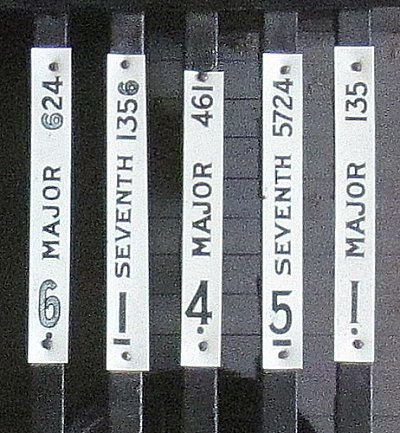I was recently explaining to a visitor why my really old autoharps have numbers instead of chord names on the chord bars, when they asked why the note numbers on these diatonic harps go 1,2,3,4,5,6,6,7? And why is the second 6 in a strange, dotted font?
Well, Charles F. Zimmerman, who popularized the autoharp in the late 19th century, and fixed the overall designs that dominate the instruments to this day, wanted to do more than sell musical instruments – he wanted to make music more accessible to people who didn’t read music at all. So he invented a note numbering system, based around the C scale (the white notes of the piano).
But Zimmerman also included Bb in his scale. (He was of German descent, so he had to – Germans consider Bb as a sort of bastard child of the C scale.) So the second 6 actually means A#. Go figure.
He also numbered the chords on his autoharp in relationship to the C chord. So C was 1, F was 4, and G was 5.

Which worked great until he wanted to add a Bb chord bar. The seventh note of the C scale is B natural, not Bb (I realize that Blues musicians will have trouble with that sentence). So, sticking with his note numbering system, he called the Bb chord “6,” but put it in a funny typeface so you would know he meant “6#.”
Confused? So were builders of competing brands, one of which accidentally labeled the Bb chord both 6# and 7# (which is technically C).
The system broke down when autoharps began getting even more chords. But if you’ve ever come across one of those old instruments, such as the popular “Favorite,” and you wondered how to tune it, the article we wrote to explain all of this should help you figure it out. Click here for more information.






Hi Paul,
I found an old zither or autoharp that belonged to my Dad’s grandma and only marking is 5047 engraved on the back. I would love to find put more about it. Can you help point me in the right direction? I have researched on line but can’t find one that has hole at mouth and another at the bottom. Thanks
Melissa, I’m going to e-mail you so you can send me a photo of the instrument.
Also, our article “Autoharp Precursors” describes several classes of zither that were being made about the same time the autoharp was invented. https://creekdontrise.com/acoustic/autoharp/goofy/autoharp_precursors.htm